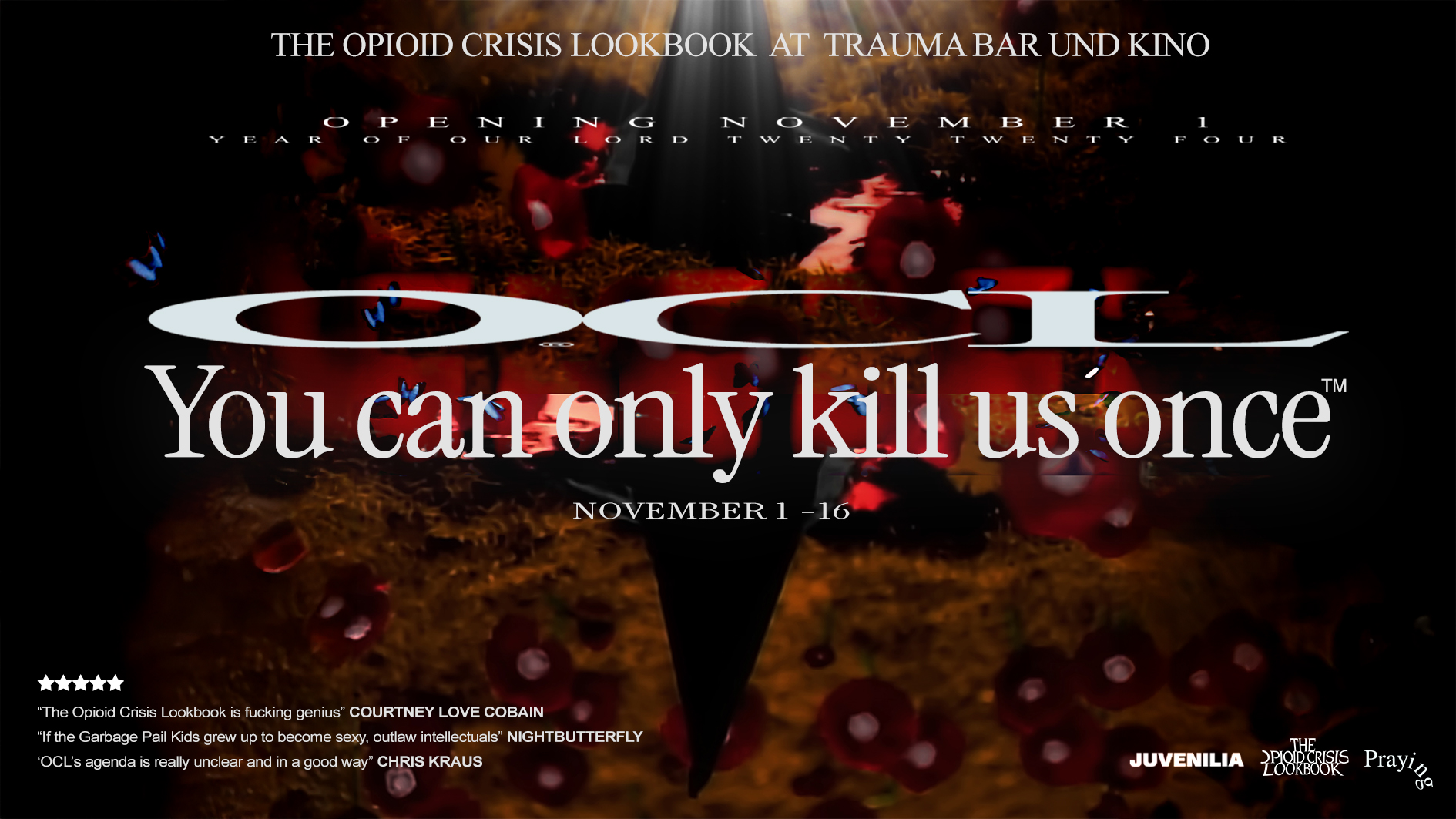TRAUMA Presents: ‘You Can Only Kill Us Once’ by The Opioid Crisis Lookbook

Artwork: The Opioid Crisis Lookbook
TRAUMA Presents: ‘You Can Only Kill Us Once’ by The Opioid Crisis Lookbook
November 1-16, 2024
Opening: Friday November 1, 20:00
———
In 1996, the Sackler family’s Purdue Pharma unleashed the drug OxyContin, falsely marketing it as a “safe” opioid painkiller despite its high addiction risks. Purdue aggressively pushed for opioid deregulation, expanding its use from treating chronic pain to any pain. Fueled by billions in profits, Purdue flooded the market as misinformed doctors over prescribed the drug nationwide. Deregulation, bribes, and relentless marketing drove mass overprescription, igniting the deadliest public health epidemic in U.S. history; with millions of casualties, 100,000 overdose deaths annually since 2021, 2.1 million chained to opioid addiction, and 200 Americans dying from overdoses daily, as heroin becomes scarcer and viscous synthetic opioids fill the gaps, bank accounts and graveyards fast and steady.
The Opioid Crisis Lookbook (OCL) was founded by Dustin Cauchi in late 2019 as a reaction to the unfolding North American Opioid Crisis. Its initial objectives were those of mapping & documenting the crisis by focusing on marginal narratives and offering a re-reading of dominant narratives, destigmatizing addiction whilst celebrating the cultures that the crisis was creating, in all their monstrosity and sublimity, guilt and taboo free. OCL amassed a cult following and quickly evolved into a magazine with Issue 1 being released in late 2020 followed by issues two and three in 2021 and 2024 and a special, launched at Schinkel Pavillon, Berlin in 2022. OCL had launches and events in Paris, Mexico City, Detroit, Los Angeles & New York City.
With “You Can Only Kill Us Once,” TRAUMA presents the first major European show by The Opioid Crisis Lookbook, curated by Dustin Cauchi, Dasha Zaharova and Samuel Staples, and including works by Zaharova, Cauchi and Liam Denhamer. The show features architecture designed by Juvenilia and inspired by the scenographic drawings of Kurt Cobain. Archival video work and imagery merge alongside new works in various temporalities and scenographic spaces - A crooner in Cobain’s poppy field, a giant tarp structure reminiscent of LA’s homeless encampments, manic archival and never-seen-before imagery and video, its own OST by Bill Kouligas with Marco Freivogel, and live music and performative elements from US & EU based artists. Offering an immersive neo-grunge experience, and initiation into the OCL multiverse that will leave all attending changed.
By 1994, Kurt Cobain had become a cultural symbol and voice of a generation. But he was also the symbol of the transition from the pre-opioid crisis in America to the crisis itself, from the War on Drugs’ “Just say no” campaigns to a United States where one in seven suffers from opioid use disorder or has a relative who does. Recent studies suggest that the death toll is expected to rise to at least a million more marytr deaths between now and 2030 if no radical change is implemented.
Cobain never lived to see an Oxy, but the post-Cobain world experienced mutations of neoliberal logic that would sow the seeds of the American opioid crisis almost immediately after his suicide. Beginning in the early 1990s, the influx of neoliberal modes of governance in the US created a system that made it possible for corporate interests and large pharmaceutical companies to promote, produce, and market opioids. Crises tend to expose the workings and structural elements of power logic. And so, the opioid crisis offers an understanding of the complexity of the modern socio-political and economic context wherein neoliberalism reigns supreme.
Yet, From the dark puddles of Martyr blood, endless cultures of resistance have spawned. Pin-pupiled ferals born into the ice-cold embrace of death. The spiky cribs that nursed them were mass-produced by soulless machines owned by the likes of the Sacklers. Evil assimilated into neoliberal world order, that like the Nazgul king, the Witch King of Angmar in LOTR lore also cannot be killed by any living man. Luckily, you can only kill us once and all of us dead and risen are indefinable.
You can only kill us once; make it count.
Curators: Dustin Cauchi, Dasha Zaharova and Samuel Staples
Artists: Dustin Cauchi, Dasha Zaharova and Liam Denhamer
Architecture: JUVENILIA (Liam Denhamer)
Sound: Bill Kouligas with Marco Freivogel
Production director: Erik Felfalusi
Production Assistant: Wera Nowak
Music curation: Kyle Van Horn, Leonardo Liccini in collaboratiion with OCL
Progam overview: Madalina Stanescu, Troels Primdahl
Inspired by the scenographic drawings of Kurt Cobain
The exibition is produced by Trauma Arts abd Culture gGmbH